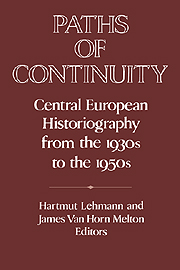Book contents
- Frontmatter
- Introduction: Continuities in German Historical Scholarship, 1933-1960
- 1 German Historiography from the 1930s to the 1950s
- 2 Friedrich Meinecke (1862-1954)
- 3 Change and Continuity in German Historiography from 1933 into the Early 1950s: Gerhard Ritter (1888-1967)
- 4 Hans Rothfels (1891-1976)
- 5 Franz Schnabel (1887-1966)
- 6 Heinrich Ritter von Srbik (1878-1951)
- 7 “Historical Social Science” and Political Myth: Hans Freyer (1887-1969) and the Genealogy of Social History in West Germany
- 8 Some Observations on the Work of Hermann Aubin (1885-1969)
- 9 From Folk History to Structural History: Otto Brunner (1898-1982) and the Radical-Conservative Roots of German Social History
- 10 Werner Conze (1910-1986): The Measure of History and the Historian's Measures
- 11 Continuity, Innovation, and Self-Reflection in Late Historicism: Theodor Schieder (1908-1984)
- Index
6 - Heinrich Ritter von Srbik (1878-1951)
Published online by Cambridge University Press: 05 January 2013
- Frontmatter
- Introduction: Continuities in German Historical Scholarship, 1933-1960
- 1 German Historiography from the 1930s to the 1950s
- 2 Friedrich Meinecke (1862-1954)
- 3 Change and Continuity in German Historiography from 1933 into the Early 1950s: Gerhard Ritter (1888-1967)
- 4 Hans Rothfels (1891-1976)
- 5 Franz Schnabel (1887-1966)
- 6 Heinrich Ritter von Srbik (1878-1951)
- 7 “Historical Social Science” and Political Myth: Hans Freyer (1887-1969) and the Genealogy of Social History in West Germany
- 8 Some Observations on the Work of Hermann Aubin (1885-1969)
- 9 From Folk History to Structural History: Otto Brunner (1898-1982) and the Radical-Conservative Roots of German Social History
- 10 Werner Conze (1910-1986): The Measure of History and the Historian's Measures
- 11 Continuity, Innovation, and Self-Reflection in Late Historicism: Theodor Schieder (1908-1984)
- Index
Summary
In a symposium devoted to the theme of continuity in Central European historical studies from the 1930s to the end of the 1950s, it may at first glance appear surprising and strange to find the name of a historian whose work was devoted to what he himself called a “pan-German historical view.” And it will no doubt be even more surprising to see Heinrich von Srbik named alongside Franz Schnabel and Gerhard Ritter. After all, the records of these three historians, whose work and impact are said to exhibit “the persistence of perspectives inherited from the nineteenth century,” are of different, even opposing characters. Franz Schnabel was a Catholic scholar from southern Germany whose teaching privileges were revoked by the National Socialist regime. Gerhard Ritter was a convinced German nationalist and Protestant champion of the discipline who participated in the resistance to National Socialism. Heinrich von Srbik was a historiographer disinclined by his nature toward any extreme, who, in his effort to do justice to Austria's important contribution to German history, allowed himself to be seduced into membership in the National Socialist German Reichstag as the representative of his Austrian fatherland.
Franz Schnabel's influence on German historical studies in the years between 1933 and 1945 was limited to the acceptance of his major work on nineteenth-century history by narrower specialists, but also by the student public of those years, and was not brought to bear fully until the end of the Third Reich, when he just as reluctantly as persistently influenced the reconstruction of German historical studies from his chair in Munich.
- Type
- Chapter
- Information
- Paths of ContinuityCentral European Historiography from the 1930s to the 1950s, pp. 171 - 196Publisher: Cambridge University PressPrint publication year: 1994
- 1
- Cited by



